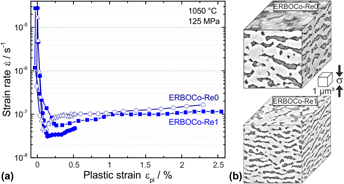Crossref Citations
This article has been cited by the following publications. This list is generated based on data provided by
Crossref.
Liu, Wusong
Miao, Naihua
Zhu, Linggang
Zhou, Jian
and
Sun, Zhimei
2017.
Adsorption and diffusion of hydrogen and oxygen in FCC-Co: a first-principles study.
Physical Chemistry Chemical Physics,
Vol. 19,
Issue. 48,
p.
32404.
Volz, N.
Zenk, C. H.
Cherukuri, R.
Kalfhaus, T.
Weiser, M.
Makineni, S. K.
Betzing, C.
Lenz, M.
Gault, B.
Fries, S. G.
Schreuer, J.
Vaßen, R.
Virtanen, S.
Raabe, D.
Spiecker, E.
Neumeier, S.
and
Göken, M.
2018.
Thermophysical and Mechanical Properties of Advanced Single Crystalline Co-base Superalloys.
Metallurgical and Materials Transactions A,
Vol. 49,
Issue. 9,
p.
4099.
Sverdrup, Harald Ulrik
Olafsdottir, Anna Hulda
Ragnarsdottir, Kristin Vala
and
Koca, Deniz
2018.
A System Dynamics Assessment of the Supply of Molybdenum and Rhenium Used for Super-alloys and Specialty Steels, Using the WORLD6 Model.
BioPhysical Economics and Resource Quality,
Vol. 3,
Issue. 3,
Yu, Jinxin
Guo, Shun
Chen, Yuechao
Han, Jiajia
Lu, Yong
Jiang, Qingshan
Wang, Cuiping
and
Liu, Xingjun
2019.
A two-stage predicting model for γ′ solvus temperature of L12-strengthened Co-base superalloys based on machine learning.
Intermetallics,
Vol. 110,
Issue. ,
p.
106466.
Li, Lingling
Wang, Cuiping
Chen, Yuechao
Yang, Shuiyuan
Yang, Mujin
Zhang, Jinbin
Lu, Yong
Han, Jiajia
and
Liu, Xingjun
2019.
Effect of Re on microstructure and mechanical properties of γ/γʹ Co-Ti-based superalloys.
Intermetallics,
Vol. 115,
Issue. ,
p.
106612.
Pandey, P.
Sawant, A.K.
Nithin, B.
Peng, Z.
Makineni, S.K.
Gault, B.
and
Chattopadhyay, K.
2019.
On the effect of Re addition on microstructural evolution of a CoNi-based superalloy.
Acta Materialia,
Vol. 168,
Issue. ,
p.
37.
Khatavkar, Nikhil
Swetlana, Sucheta
and
Singh, Abhishek Kumar
2020.
Accelerated prediction of Vickers hardness of Co- and Ni-based superalloys from microstructure and composition using advanced image processing techniques and machine learning.
Acta Materialia,
Vol. 196,
Issue. ,
p.
295.
Zenk, Christopher H.
Volz, Nicklas
Bezold, Andreas
Huber, Laura-Kristin
Eggeler, Yolita M.
Spiecker, Erdmann
Göken, Mathias
and
Neumeier, Steffen
2020.
Superalloys 2020.
p.
909.
Pandey, Prafull
Mukhopadhyay, Semanti
Srivastava, Chandan
Makineni, Surendra K.
and
Chattopadhyay, Kamanio
2020.
Development of new γ′-strengthened Co-based superalloys with low mass density, high solvus temperature and high temperature strength.
Materials Science and Engineering: A,
Vol. 790,
Issue. ,
p.
139578.
Reyes Tirado, Fernando L.
Taylor, Spencer V.
and
Dunand, David C.
2020.
Low-density, W-free Co–Nb–V–Al-based superalloys with γ/γ’ microstructure.
Materials Science and Engineering: A,
Vol. 796,
Issue. ,
p.
139977.
Kubacka, Dorota
Eggeler, Yolita M.
Volz, Nicklas
Neumeier, Steffen
and
Spiecker, Erdmann
2020.
Superalloys 2020.
p.
763.
Kubacka, Dorota
Weiser, Martin
and
Spiecker, Erdmann
2021.
Early stages of high-temperature oxidation of Ni- and Co-base model superalloys: A comparative study using rapid thermal annealing and advanced electron microscopy.
Corrosion Science,
Vol. 191,
Issue. ,
p.
109744.
Xue, F.
Zenk, C. H.
Freund, L. P.
Neumeier, S.
and
Göken, M.
2021.
Understanding raft formation and precipitate shearing during double minimum creep in a γ′-strengthened single crystalline Co-base superalloy.
Philosophical Magazine,
Vol. 101,
Issue. 3,
p.
326.
Makineni, Surendra Kumar
Singh, Mahander Pratap
and
Chattopadhyay, Kamanio
2021.
Low-Density, High-Temperature Co Base Superalloys.
Annual Review of Materials Research,
Vol. 51,
Issue. 1,
p.
187.
Ohl, Brandon
and
Dunand, David C.
2022.
Effects of Ni and Cr Additions on Γ + Γ’ Microstructure and Mechanical Properties of W-Free Co-Al-V-Nb-Ta-Based Superalloys.
SSRN Electronic Journal ,
Ohl, Brandon
and
Dunand, David C.
2022.
Effects of Ni and Cr additions on γ + γ’ microstructure and mechanical properties of W-free Co–Al–V–Nb–Ta-based superalloys.
Materials Science and Engineering: A,
Vol. 849,
Issue. ,
p.
143401.
Makineni, Surendra K
Sharma, Abhishek
Pandey, Prafull
and
Chattopadhyay, Kamanio
2022.
Encyclopedia of Materials: Metals and Alloys.
p.
323.
Strutt, V.C.I.
Jenkins, B.M.
Woolrich, J.M.
Appleton, M.
Moody, M.P.
and
Bagot, P.A.J.
2023.
Effect of microsegregation and heat treatment on localised γ and γ’ compositions in single crystal Ni-based superalloys.
Journal of Alloys and Compounds,
Vol. 949,
Issue. ,
p.
169861.
Bezold, A.
Freund, L. P.
Förner, A.
Völkl, J.
Huber, L.-K.
Göken, M.
and
Neumeier, S.
2023.
Deformation Mechanisms in Compositionally Complex Polycrystalline CoNi-Base Superalloys: Influence of Temperature, Strain-Rate and Chemistry.
Metallurgical and Materials Transactions A,
Vol. 54,
Issue. 5,
p.
1649.
Ohl, Brandon
Owen, Lewis
Stone, Howard
and
Dunand, David C.
2023.
Microstructure and mechanical properties of L12-strengthened Co–Ni–Fe-based superalloys.
Materials Science and Engineering: A,
Vol. 884,
Issue. ,
p.
145276.





